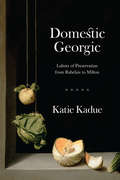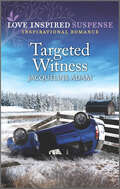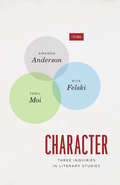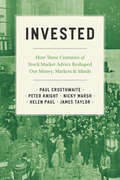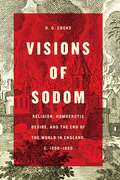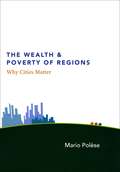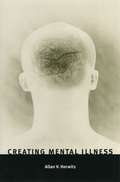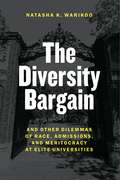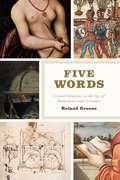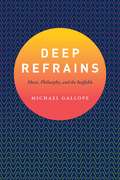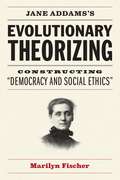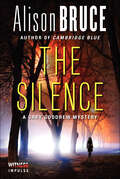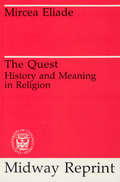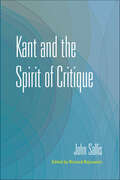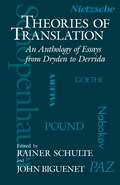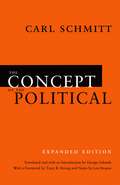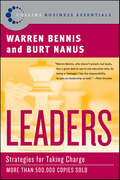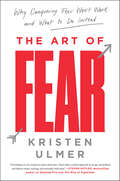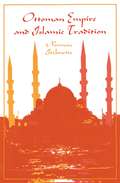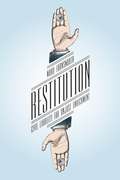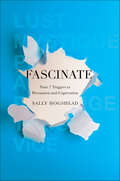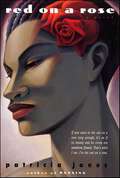- Table View
- List View
Domestic Georgic: Labors of Preservation from Rabelais to Milton
by Katie KadueInspired by Virgil’s Georgics, this study conceptualizes Renaissance poetry as a domestic labor. When is literary production more menial than inspired, more like housework than heroics of the mind? In this revisionist study, Katie Kadue shows that some of the authors we credit with groundbreaking literary feats—including Michel de Montaigne and John Milton—conceived of their writing in surprisingly modest and domestic terms. In contrast to the monumental ambitions associated with the literature of the age, and picking up an undercurrent of Virgil’s Georgics, poetic labor of the Renaissance emerges here as often aligned with so-called women’s work. Kadue reveals how male authors’ engagements with a feminized georgic mode became central to their conceptions of what literature is and could be. This other georgic strain in literature shared the same primary concern as housekeeping: the necessity of constant, almost invisible labor to keep the things of the world intact. Domestic Georgic brings into focus a conception of literary—as well as scholarly and critical—labor not as a striving for originality and fame but as a form of maintenance work that aims at preserving individual and collective life.
Targeted Witness
by Jacqueline AdamA witness under protection. A serial killer out for revenge. After the killer she identified finds her in witness protection, artist Cassie Whitfield must go on the run to avoid becoming the next victim. But there&’s nobody she can trust—except her ex-boyfriend, former FBI agent Ryan Matherson, who doesn&’t know her real identity. Now telling him the deadly truth is her only option if she wants to stay alive…From Love Inspired Suspense: Courage. Danger. Faith.
Character: Three Inquiries in Literary Studies (TRIOS)
by Amanda Anderson Toril Moi Rita FelskiOver the last few decades, character-based criticism has been seen as either naive or obsolete. But now questions of character are attracting renewed interest. Making the case for a broad-based revision of our understanding of character, Character rethinks these questions from the ground up. Is it really necessary to remind literary critics that characters are made up of words? Must we forbid identification with characters? Does character-discussion force critics to embrace humanism and outmoded theories of the subject? Across three chapters, leading scholars Amanda Anderson, Rita Felski, and Toril Moi reimagine and renew literary studies by engaging in a conversation about character. Moi returns to the fundamental theoretical assumptions that convinced literary scholars to stop doing character-criticism, and shows that they cannot hold. Felski turns to the question of identification and draws out its diverse strands, as well as its persistence in academic criticism. Anderson shows that character-criticism illuminates both the moral life of characters, and our understanding of literary form. In offering new perspectives on the question of fictional character, this thought-provoking book makes an important intervention in literary studies.
Invested: How Three Centuries of Stock Market Advice Reshaped Our Money, Markets, and Minds
by Peter Knight Nicky Marsh Paul Crosthwaite Helen PaulInvested examines the perennial and nefarious appeal of financial advice manuals. Who hasn’t wished for a surefire formula for riches and a ticket to the good life? For three centuries, investment advisers of all kinds, legit and otherwise, have guaranteed that they alone can illuminate the golden pathway to prosperity—despite strong evidence to the contrary. In fact, too often, they are singing a siren song of devastation. And yet we keep listening. Invested tells the story of how the genre of investment advice developed and grew in the United Kingdom and the United States, from its origins in the eighteenth century through today, as it saturates our world. The authors analyze centuries of books, TV shows, blogs, and more, all promising techniques for amateur investors to master the ways of the market: from Thomas Mortimer’s pathbreaking 1761 work, Every Man His Own Broker, through the Gilded Age explosion of sensationalist investment manuals, the early twentieth-century emergence of a vernacular financial science, and the more recent convergence of self-help and personal finance. Invested asks why, in the absence of evidence that such advice reliably works, guides to the stock market have remained perennially popular. The authors argue that the appeal of popular investment advice lies in its promise to level the playing field, giving outsiders the privileged information of insiders. As Invested persuasively shows, the fantasies sold by these writings are damaging and deceptive, peddling unrealistic visions of easy profits and the certainty of success, while trying to hide the fact that there is no formula for avoiding life’s economic uncertainties and calamities.
Visions of Sodom: Religion, Homoerotic Desire, and the End of the World in England, c. 1550–1850
by H.G. CocksThe book of Genesis records the fiery fate of Sodom and Gomorrah—a storm of fire and brimstone was sent from heaven and, for the wickedness of the people, God destroyed the cities “and all the plains, and all the inhabitants of the cities, and that which grew upon the ground.” According to many Protestant theologians and commentators, one of the Sodomites’ many crimes was homoerotic excess. In Visions of Sodom, H. G. Cocks examines the many different ways in which the story of Sodom’s destruction provided a template for understanding homoerotic desire and behaviour in Britain between the Reformation and the nineteenth century. Sodom was not only a marker of sexual sins, but also the epitome of false—usually Catholic—religion, an exemplar of the iniquitous city, a foreshadowing of the world’s fiery end, an epitome of divine and earthly punishment, and an actual place that could be searched for and discovered. Visions of Sodom investigates each of these ways of reading Sodom’s annihilation in the three hundred years after the Reformation. The centrality of scripture to Protestant faith meant that Sodom’s demise provided a powerful origin myth of homoerotic desire and sexual excess, one that persisted across centuries, and retains an apocalyptic echo in the religious fundamentalism of our own time.
Returning for His Unknown Son: An Uplifting International Romance
by Tara PammiA billionaire makes a deal to claim his son and his forgotten bride in this emotional amnesia story from the author of Her Twin Secret.Priya's convenient vows to notorious playboy Christian Mikkelson led to unexpected yet unparalleled pleasure. The next day, a plane crash left Christian with no idea who he was or that Priya was pregnant with his child . . .Eight years later, their worlds crash back together . . . as Christian returns to learn that he has an heir and that Priya wants to end their marriage deal. Refusing to let his family slip through his fingers, he has an electrifying counterproposal: three months of living together as husband and wife!From Harlequin Presents: Escape to exotic locations where passion knows no bounds.“I adored this story. The amnesia was very cleverly done and the background complications of their marriage of convenience was explained well.” —Harlequin Junkie (5 stars)
The Wealth & Poverty of Regions: Why Cities Matter
by Mario PolèseAs the world becomes more interconnected through travel and electronic communication, many believe that physical places will become less important. But as Mario Polèse argues in The Wealth and Poverty of Regions, geography will matter more than ever before in a world where distance is allegedly dead.This provocative book surveys the globe, from London and Cape Town to New York and Beijing, contending that regions rise—or fall—due to their location, not only within nations but also on the world map. Polèse reveals how concentrations of industries and populations in specific locales often result in minor advantages that accumulate over time, resulting in reduced prices, improved transportation networks, increased diversity, and not least of all, “buzz”—the excitement and vitality that attracts ambitious people. The Wealth and Poverty of Regions maps out how a heady mix of size, infrastructure, proximity, and cost will determine which urban centers become the thriving metropolises of the future, and which become the deserted cities of the past. Engagingly written, the book provides insight to the past, present, and future of regions.
Creating Mental Illness
by Allan V. Horwitz&“Filled with insights into the social, historical, and economic forces responsible for the overmedicalization of human unhappiness and distress.&” —George Graham, Metapsychology In this surprising book, Allan V. Horwitz argues that our current conceptions of mental illness as a disease fit only a small number of serious psychological conditions and that most conditions currently regarded as mental illness are cultural constructions, normal reactions to stressful social circumstances, or simply forms of deviant behavior.&“Thought-provoking and important . . . Drawing on and consolidating the ideas of a range of authors, Horwitz challenges the existing use of the term mental illness and the psychiatric ideas and practices on which this usage is based . . . Horwitz enters this controversial territory with confidence, conviction, and clarity.&” —Joan Busfield, American Journal of Sociology&“Horwitz properly identifies the financial incentives that urge therapists and drug companies to proliferate psychiatric diagnostic categories. He correctly identifies the stranglehold that psychiatric diagnosis has on research funding in mental health. Above all, he provides a sorely needed counterpoint to the most strident advocates of disease-model psychiatry.&” —Mark Sullivan, Journal of the American Medical Association&“Horwitz makes at least two major contributions to our understanding of mental disorders. First, he eloquently draws on evidence from the biological and social sciences to create a balanced, integrative approach to the study of mental disorders. Second, in accomplishing the first contribution, he provides a fascinating history of the study and treatment of mental disorders . . . from early asylum work to the rise of modern biological psychiatry.&”— Debra Umberson, Quarterly Review of Biology
The Diversity Bargain: And Other Dilemmas of Race, Admissions, and Meritocracy at Elite Universities
by Natasha K. WarikooWe’ve heard plenty from politicians and experts on affirmative action and higher education, about how universities should intervene—if at all—to ensure a diverse but deserving student population. But what about those for whom these issues matter the most? In this book, Natasha K. Warikoo deeply explores how students themselves think about merit and race at a uniquely pivotal moment: after they have just won the most competitive game of their lives and gained admittance to one of the world’s top universities. What Warikoo uncovers—talking with both white students and students of color at Harvard, Brown, and Oxford—is absolutely illuminating; and some of it is positively shocking. As she shows, many elite white students understand the value of diversity abstractly, but they ignore the real problems that racial inequality causes and that diversity programs are meant to solve. They stand in fear of being labeled a racist, but they are quick to call foul should a diversity program appear at all to hamper their own chances for advancement. The most troubling result of this ambivalence is what she calls the “diversity bargain,” in which white students reluctantly agree with affirmative action as long as it benefits them by providing a diverse learning environment—racial diversity, in this way, is a commodity, a selling point on a brochure. And as Warikoo shows, universities play a big part in creating these situations. The way they talk about race on campus and the kinds of diversity programs they offer have a huge impact on student attitudes, shaping them either toward ambivalence or, in better cases, toward more productive and considerate understandings of racial difference. Ultimately, this book demonstrates just how slippery the notions of race, merit, and privilege can be. In doing so, it asks important questions not just about college admissions but what the elite students who have succeeded at it—who will be the world’s future leaders—will do with the social inequalities of the wider world.
Five Words: Critical Semantics in the Age of Shakespeare and Cervantes
by Roland GreeneBlood. Invention. Language. Resistance. World. Five ordinary words that do a great deal of conceptual work in everyday life and literature. In this original experiment in critical semantics, Roland Greene considers how these words changed over the course of the sixteenth century and what their changes indicate about broader forces in science, politics, and other disciplines. Rather than analyzing works, careers, or histories, Greene discusses a broad swath of Renaissance and transatlantic literature—including Shakespeare, Cervantes, Camões, and Milton—in terms of the development of these five words. Aiming to shift the conversation around Renaissance literature from current approaches to riskier enterprises, Greene also proposes new methods that take advantage of digital resources like full-text databases, but still depend on the interpreter to fashion ideas out of ordinary language. Five Words is an innovative and accessible book that points the field of literary studies in an exciting new direction.
Deep Refrains: Music, Philosophy, and the Ineffable
by Michael GallopeWe often say that music is ineffable, that it does not refer to anything outside of itself. But if music, in all its sensuous flux, does not mean anything in particular, might it still have a special kind of philosophical significance? In Deep Refrains, Michael Gallope draws together the writings of Arthur Schopenhauer, Friedrich Nietzsche, Ernst Bloch, Theodor Adorno, Vladimir Jankélévitch, Gilles Deleuze, and Félix Guattari in order to revisit the age-old question of music’s ineffability from a modern perspective. For these nineteenth- and twentieth-century European philosophers, music’s ineffability is a complex phenomenon that engenders an intellectually productive sense of perplexity. Through careful examination of their historical contexts and philosophical orientations, close attention to their use of language, and new interpretations of musical compositions that proved influential for their work, Deep Refrains forges the first panoptic view of their writings on music. Gallope concludes that music’s ineffability is neither a conservative phenomenon nor a pious call to silence. Instead, these philosophers ask us to think through the ways in which music’s stunning force might address, in an ethical fashion, intricate philosophical questions specific to the modern world.
Jane Addams's Evolutionary Theorizing: Constructing “Democracy and Social Ethics”
by Marilyn FischerIn Jane Addams’s Evolutionary Theorizing, Marilyn Fischer advances the bold and original claim that Addams’s reasoning in her first book, Democracy and Social Ethics, is thoroughly evolutionary. While Democracy and Social Ethics, a foundational text of classical American pragmatism, is praised for advancing a sensitive and sophisticated method of ethical deliberation, Fischer is the first to explore its intellectual roots. Examining essays Addams wrote in the 1890s and showing how they were revised for Democracy and Social Ethics, Fischer draws from philosophy, history, literature, rhetoric, and more to uncover the array of social evolutionary thought Addams engaged with in her texts—from British socialist writings on the evolution of democracy to British and German anthropological accounts of the evolution of morality. By excavating Addams’s evolutionary reasoning and rhetorical strategies, Fischer reveals the depth, subtlety, and richness of Addams’s thought.
The Silence: A Gary Goodhew Mystery (The Gary Goodhew Mysteries #4)
by Alison BruceA rash of unexplained suicides. An old woman’s baffling illness. A brutal murder. Detective Gary Goodhew must figure out what's connecting them—or die trying . . .The esteemed Detective Gary Goodhew must solve a disturbing puzzle when he stumbles upon a circle of friends who seem to be afflicted by a plague of teenage suicides. Poor Charlotte Stone . . . her whole life she has been burdened by grief. First her terminally ill mother dies and then, just weeks later two of her childhood friends take their own lives. Detective Goodhew begins to realize that this web of tragedy is not woven by coincidence. In his search for the link between this series of deaths, Goodhew is forced to recall deeply buried memories of a murder investigation that went cold years ago—memories that lead him to Charlotte Stone. Together they must stop the course of events set in motion years ago . . .In this unforgettable novel, Alison Bruce twists a shocking tale that will thrill fans of Deborah Crombie and Tana French.
The Quest: History and Meaning in Religion (Midway Reprint)
by Mircea EliadeIn The Quest Mircea Eliade stresses the cultural function that a study of the history of religions can play in a secularized society. He writes for the intelligent general reader in the hope that what he calls a new humanism "will be engendered by a confrontation of modern Western man with unknown or less familiar worlds of meaning." "Each of these essays contains insights which will be fruitful and challenging for professional students of religion, but at the same time they all retain the kind of cultural relevance and clarity of style which makes them accessible to anyone seriously concerned with man and his religious possibilities."—Joseph M. Kitagawa, Religious Education
Kant and the Spirit of Critique (The Collected Writings of John Sallis)
by John SallisThis volume of the Collected Writings of John Sallis presents his lecture courses on Kant. Each course was devoted respectively to one of Kant's three Critiques, and so the book as a whole treats the entirety of the Kantian critical project. Sallis displays here, as he does in all his lecture courses, an uncanny ability to open up dense philosophical texts. The matters Kant deals with—in theoretical, practical, and aesthetic philosophy—are difficult in themselves, and Kant's writings might at times seem so convoluted as to magnify the difficulty. Sallis patiently and successfully lays out the issues and the critical approach to them, such that the reader is led step by step into the very core of Kant's spirit of critique. This volume makes Kant accessible to students, while the most advanced scholars will also profit from it.
Theories of Translation: An Anthology of Essays from Dryden to Derrida
by Rainer Schulte and John BiguenetSpanning the centuries, from the seventeenth to the twentieth, and ranging across cultures, from England to Mexico, this collection gathers together important statements on the function and feasibility of literary translation. The essays provide an overview of the historical evolution in thinking about translation and offer strong individual opinions by prominent contemporary theorists. Most of the twenty-one pieces appear in translation, some here in English for the first time and many difficult to find elsewhere. Selections include writings by Scheiermacher, Nietzsche, Ortega, Benjamin, Pound, Jakobson, Paz, Riffaterre, Derrida, and others. A fine companion to The Craft of Translation, this volume will be a valuable resource for all those who translate, those who teach translation theory and practice, and those interested in questions of language philosophy and literary theory.
The Concept of the Political: Expanded Edition (None Ser.)
by Carl Schmitt“Arguably Schmitt’s most influential work . . . recognized as one of the most important tracts of modern political thought.” —Samuel Earle, The New StatesmanIn this, his most influential work, legal theorist and political philosopher Carl Schmitt argues that liberalism’s basis in individual rights cannot provide a reasonable justification for sacrificing oneself for the state—a critique as cogent today as when it first appeared. George Schwab’s introduction to his translation of the 1932 German edition highlights Schmitt’s intellectual journey through the turbulent period of German history leading to the Hitlerian one-party state. In addition to analysis by Leo Strauss and a foreword by Tracy B. Strong placing Schmitt’s work into contemporary context, this expanded edition also includes a translation of Schmitt’s 1929 lecture “The Age of Neutralizations and Depoliticizations,” which the author himself added to the 1932 edition of the book. An essential update on a modern classic, The Concept of the Political, Expanded Edition belongs on the bookshelf of anyone interested in political theory or philosophy.“Contains much of what is fundamental in Schmitt’s understanding of the political nature of man and the state, including his contentious definition of the political as the distinction between friend and enemy . . . Its scholarship is unquestionable.” —Joseph W. Bendersky, Canadian Journal of Political and Social Theory“The best introduction to Schmitt’s thought.” —Mark Lilla, New York Review of Books“[A] foundational work . . . Minor disagreements over terms fade . . . in light of the superb job Schwab has done rendering Schmitt’s long, multi-clausal German sentences into concise, pellucid English.” —Robert D. Rachlin, HNet
Leaders: The Strategies for Taking Charge (Collins Business Essentials)
by Warren Bennis Burt Nanus“An insightful book that should be read by every manager aspiring to be a true leader. . . . One of the most important books of its type” (Chicago Tribune).In this illuminating study of corporate America’s most critical issue—leadership—world-renowned leadership guru Warren Bennis and his co-author Burt Nanus reveal the four key principles every manager should know: Attention Through Vision, Meaning Through Communication, Trust Through Positioning, and The Deployment of Self.In this age of “process,” with downsizing and restructuring affecting many workplaces, companies have fallen trap to lack of communication and distrust, and vision and leadership are needed more than ever before. The wisdom and insight in Leaders address this need. It is an indispensable source of guidance all readers will appreciate, whether they’re running a small department or in charge of an entire corporation.“One of the top fifty business books of all time.” —Financial Times“At a time when corporations need fewer managers to hold things in place and more leaders to guide change, this book provides a valuable addition to an executive’s repertoire.” —Rosabeth Moss Kanter“All American managers should listen closely to this message and act! Warren Bennis and Burt Nanus have written a masterpiece, a thriller. . . . We owe these two men a debt of gratitude.” —Tom Peters
The Art of Fear: Why Conquering Fear Won't Work and What to Do Instead
by Kristen UlmerThe former professional extreme skier “unpacks this misunderstood emotion and lays out strategies for experiencing fear in an empowering way” (Parade).We all feel fear. Yet we are often taught to ignore it, overcome it, push past it. But to what benefit? This is the essential question that guides Kristen Ulmer’s remarkable exploration of our most misunderstood emotion in The Art of Fear.Once recognized as the best extreme skier in the world (an honor she held for twelve years), Ulmer knows fear well. In this conversation-changing book, she argues that fear is not here to cause us problems—and that in fact, the only true issue we face with fear is our misguided reaction to it (not the fear itself).Rebuilding our experience with fear from the ground up, Ulmer starts by exploring why we’ve come to view it as a negative. From here, she unpacks fear and shows it to be just one of 10,000 voices that make up our reality, here to help us come alive alongside joy, love, and gratitude. Introducing a mindfulness tool called “Shift,” Ulmer teaches readers how to experience fear in a simpler, more authentic way, transforming our relationship with this emotion from that of a draining battle into one that’s in line with our true nature.Influenced by Ulmer’s own complicated relationship with fear and her over fifty years as a mindset facilitator, The Art of Fear will reconstruct the way we react to and experience fear—empowering us to easily and permanently address the underlying cause of our fear-based problems, and setting us on course to live a happier, more expansive future.
Ottoman Empire and Islamic Tradition (A Phoenix book)
by Norman ItzkowitzThis skillfully written text presents the full sweep of Ottoman history from its beginnings on the Byzantine frontier in about 1300, through its development as an empire, to its late eighteenth-century confrontation with a rapidly modernizing Europe. Itzkowitz delineates the fundamental institutions of the Ottoman state, the major divisions within the society, and the basic ideas on government and social structure. Throughout, Itzkowitz emphasizes the Ottomans' own conception of their historical experience, and in so doing penetrates the surface view provided by the insights of Western observers of the Ottoman world to the core of Ottoman existence.
Restitution: Civil Liability for Unjust Enrichment
by Ward FarnsworthRestitution is the body of law concerned with taking away gains that someone has wrongfully obtained. The operator of a Ponzi scheme takes money from his victims by fraud and then invests it in stocks that rise in value. Or a company pays a shareholder excessive dividends or pays them to the wrong person. Or a man poisons his grandfather and then collects under the grandfather’s will. In each of these cases, one party is unjustly enriched at the expense of another. And in all of them the law of restitution provides a way to undo the enrichment and transfer the defendant’s gains to a party with better rights to them. Tort law focuses on the harm, or costs, that one party wrongfully imposes on another. Restitution is the mirror image; it corrects gains that one party wrongfully receives at another’s expense. It is an important topic for every lawyer and for anyone else interested in how the legal system responds to injustice. In Restitution, Ward Farnsworth presents a guide to this body of law that is compact, lively, and insightful—the first treatment of its kind that the American law of restitution has received. The book explains restitution doctrines, remedies, and defenses with unprecedented clarity and illustrates them with vivid examples. Farnsworth demonstrates that the law of restitution is guided by a manageable and coherent set of principles that have remarkable versatility and power. Restitution makes a complex and important area of law accessible, understandable, and interesting to any reader.
Hired by the Forbidden Italian
by Cathy WilliamsIn this workplace romance from USA TODAY bestselling author Cathy Williams, is resisting their attraction futile? On the tycoon&’s yacht…There&’s no escape from temptation! Urgently in need of a nanny for his young daughter, superrich Italian single father Niccolo Ferri hires Sophie Baxter to accompany them on a business trip aboard his superyacht. Niccolo&’s only priority is his child, but he finds himself unusually intrigued by his temporary employee… Working for Niccolo is what&’s keeping Sophie financially afloat. So her connection with her sinfully sexy boss can&’t be anything more than professional. Because Sophie knows she&’ll be in far too deep if she has even one taste of the forbidden!From Harlequin Presents: Escape to exotic locations where passion knows no bounds.
Dr. Susan Taylor's Rx for Brown Skin: Your Prescription for Flawless Skin, Hair, and Nails
by Susan C. TaylorBrown skin has a naturally warm, glowing complexion that ranges in shade from yellow to olive to dark brown and black (Asian, Latin, African-American, and Native American skin). The extra melanin that imparts these rich tones and helps protect skin from the sun can also make brown skin vulnerable to discoloration, uneven tone, scarring, and breakouts. This unique book will help you enhance and protect the health and beauty of your brown skin, as well as your hair and nails. Dr. Susan Taylor, a Harvard-trained dermatologist, bases her advice on more than twenty years of experience treating patients in private practice and at the Skin of Color Center in New York City, which she founded. Dr. Taylor explains how to: Attain and maintain flawless skin Avoid breakouts, discolorations, and ashen skin Prevent and camouflage scars Choose and use makeup for a perfect match year-round Style hair safely to avoid damage, hair loss, and skin irritation Detect and protect against skin cancer . . . and much more!
Fascinate: Your 7 Triggers to Persuasion and Captivation
by Sally Hogshead“Fascination . . . the most powerful of product attachments . . . this pioneering book helps us approach . . . the concept in a thoughtful . . . practical manner.” —Tom Peters, national bestselling author of In Search of ExcellenceIn an oversaturated culture defined by limited time and focus, how do we draw attention to our messages, our ideas, and our products when we only have seconds to compete?Award-winning consultant and speaker Sally Hogshead turned to a wide realm of disciplines, including neurobiology, psychology, and evolutionary anthropology. She began to see specific and interesting patterns that all centered on one element: fascination.Fascination is the most powerful way to capture an audience and influence behavior. This essential book, newly revised and updated, examines the principles behind fascination and explores how those insights can be put to use to sway:• Which brand of frozen peas you pick in the case• Which city, neighborhood, and house you choose• Which profession and company you join• Where you go on vacation• Which book you buy off the shelfStructured around the seven languages of fascination Hogshead has studied and developed—power, passion, innovation, alarm, mystique, prestige, and alert—Fascinate explores how anyone can use these triggers to make products, messages, and services more fascinating—and more successful.“A transformative work, a beautifully written book that will forever change the way you see the world.” —Seth Godin, author of Linchpin“A riveting journey through the forces of fascination—how it irresistibly shapes our ideas, opinions, and relationships—and how to wield it to your advantage.” —Alan Webber, co-found, Fast Company and author of Rules of Thumb“This slight but practical work packs a big punch.” —Publishers Weekly
Red on a Rose: A Novel
by Patricia JonesIn a captivating voice that wafts around you like a rose's rich fragrance, Patricia ]ones peels back the petals of emotion that blanket a woman's soul and, in this poignant and wise novel, tells a powerful story of love and redemption.Lila Giles Calloway has come a long way since she stepped out from under her stepmother's controlling thumb. Happily married to cardiac surgeon Jack Calloway and living in her beloved hometown of Baltimore, Lila splits her time among visiting with Jack's elderly patients, directing her own on-line reading program for children, and contemplating the possibility of motherhood. But all this comes to a screeching halt when, one typical Saturday afternoon, Lila is confronted with a situation that challenges the very core of her moral fiber. In a split second, the idyllic life lack and Lila have built together is threatened, and suddenly she must reconcile the truth that there's a bit of evil in all of us with her love for her husband and her faith in her life's purpose.
